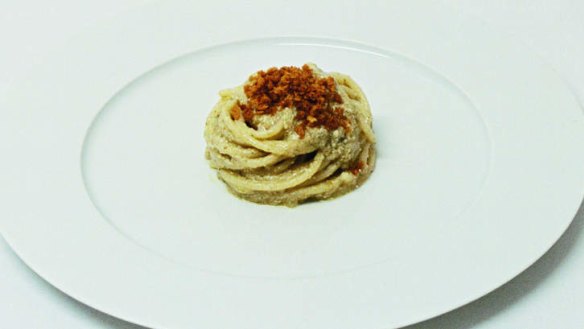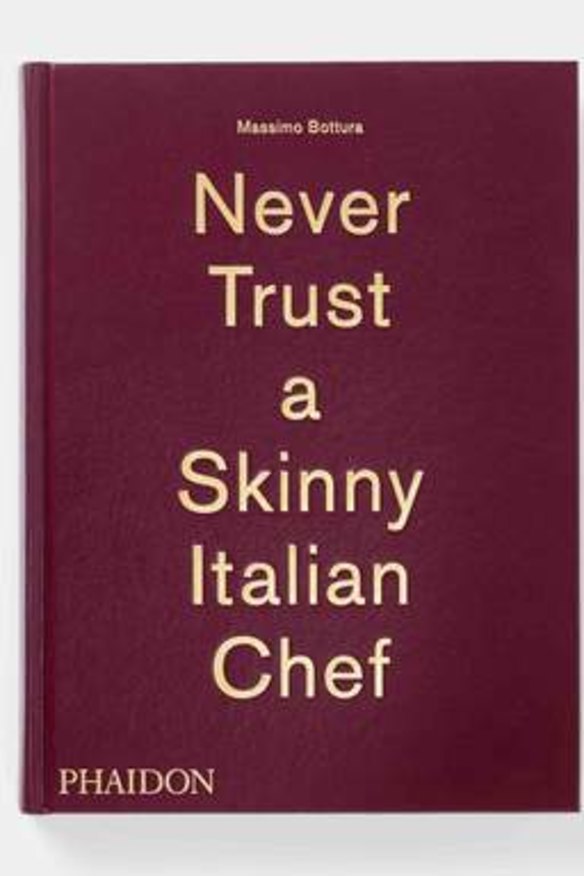Massimo Bottura's recipes for ragu and spaghetti cetarese
How does the world's best Italian chef inject a little romance back into some everyday national dishes?

This recipe for ragu is Massimo Bottura's answer to spaghetti bolognese.
Basic ragu
extra-virgin olive oil

1 large white onion
1 large carrot, peeled and diced
1 large celery stalk, peeled and diced
20g plain flour
100g chopped pancetta
150g veal (including cheek, tongue or shank)
150g beef (gelatinous cuts, including tail if available)
100g bone marrow (already removed from bone)
50g sausage, broken but not ground (optional)
1 bay leaf and 1 sprig rosemary
½ a glass red wine such as sangiovese
3 cups stock (veg, chicken or beef)
1. Prepare a soffritto in a deep and heavy bottomed pan by adding diced onion, carrot and celery to pan warmed with olive oil. Simmer on low for about 15 minutes or until onions are glassy and carrots tender.
2. Melt and crisp pancetta in a separate skillet on medium for about five minutes. Add pancetta to soffritto.
3. Flour the chunks of meat in a bowl or on working surface. Clean pancetta skillet and warm it with olive oil then add the meat. Lightly brown. Add the wine. Raise heat and continue cooking until wine evaporates.
4. Add meat to soffritto and pancetta mix.
5. Clean skillet and brown the bone marrow in a drop of olive oil.
6. Add marrow to soffritto, pancetta and meat mix.
6. Add bay leaf, rosemary, wine and stock.
7. Simmer for 1½ to two hours at a low temperature with wax paper covering and lid. (This keeps the moisture in.)
How do you know it's ready?
The meat should be very tender and falling off the bone. Take off the heat and let cool for half an hour. Take out meat, debone and cut into small pieces. Return meat to ragu. Simmer the ragu uncovered on to low heat until a thick and fragrant sauce forms.
Spaghetti Cetarese
In 1932, the Italian Futurist Filippo Tommaso Marinetti proposed a revolution in food. Absurdist banquets of idealistic food propelled esoteric dining into the future. Marinetti's vision was not far from the mark if we consider our contemporary tendencies, but back in 1932 the general public overlooked the Futurist Food movement until Marinetti struck a nerve in the Italian identity. The Futurists announced to the public that it was necessary to abolish pastasciutta, the Neapolitan tradition of dried semolina-flour pasta with sauce. One can only imagine how this was received in Naples. The streets filled with protests against the Futurist declarations. In Luce Marinetti's copy of The Futurist Cookbook there are clippings from the Chicago Tribune with the headline 'ITALY MAY DOWN SPAGHETTI'. Italians, and the entire world, divided into two camps: those who believed in the power of pasta to feed, heal and console a hungry population, and those who felt it slowed down a nation and set back progress. According to Marinetti, a French journalist went so far as to declare that pasta was 'the torpor of the masses … the origin of languid sentimentalism, serene irony, amiable indifference, and more'. Next to all the mad banquets and fantastical ideas proposed by Marinetti and the Futurists about cooking, the one that aroused the most resistance was the abolition of spaghetti.
We don't serve spaghetti regularly at Osteria Francescana. We believe our guests will feel cheated because spaghetti is so everyday; it is the most common ingredient in the Italian pantry. This dish is an exception to the rule. It is dedicated to the town of Cetara, where so many Italian flavours originate. Cetara is a town on the Amalfi coast between Naples and Salerno. Its name most likely comes from the Latin word cetaria, meaning tuna fishing, orcetari, meaning fishmongers. The fishing village is famous for canned anchovies and tuna, and a Roman seasoning called garum, made with fermented fish, is made there in the form of colatura di alici, an anchovy extract unique to Cetara. The anchovies are pressed under salt. The orange liquid that floats to the surface is placed in glass jars and exposed to full sun to eliminate any excess water and leave only a pure anchovy extract behind. Bountiful and simple, it mirrors the location in which it is made. It's like finding a bottle of sunshine when you reach into a dark cupboard.
The pesto for this spaghetti is made with hand-chopped anchovies, capers, pine nuts, garlic and colatura di alici, but the pesto is only half of it. Without a good-quality spaghetti and a proper cooking technique, this recipe will get you nowhere. We are faithful to no one when it comes to pasta, and we pick and choose from among our favourite producers. The spaghetti must be able to absorb the sauce without losing its bite. The secret is to boil it in salted water until half cooked, then remove it from the water. Add it to a warm pan with 20 drops of colatura di alici, the pesto and enough fish stock to cook it all the way through. Cetarese Spaghetti is the perfect example of the generosity of humble ingredients: with so little you get so much. You just want to keep eating it forever.
No apologies, Marinetti.
For pesto
30g salted anchovies from Cetara
100g pine nuts
65g salted capers from Pantelleria
1 garlic clove, grated
1 teaspoon Villa Manodori extra-virgin olive oil
Clean and debone the anchovies. Chop the pine nuts, capers and anchovies to make a pesto-like mixture. Use a sharp knife, not a blender. It is very important not to crush the ingredients. Add the garlic and olive oil.
Parsley oil
100g parsley
20g Villa Manodori extra-virgin olive oil
4g fine sea salt
Blanch the parsley leaves in salted boiling water for 20 seconds. Chill them immediately in iced water, then pat dry. Put them in a blender with the oil and salt and process to a velvety texture.
Garlic cream
1 head garlic, cloves halved
400g whole milk
a pinch of sea salt
a pinch of sugar
Remove the heart from each garlic clove. Marinate in half the milk overnight, covered with clingfilm (plastic wrap). Discard the milk and reserve the garlic. Bring the remaining milk to a boil with the sugar and salt. Blanch the garlic for 1 minute in the milk, then remove it. Repeat this twice. Put the garlic in a separate container and use just enough of the milk to blend it to a creamy paste with a hand-held blender.
Crunchy breadcrumbs
200g two-day-old sourdough bread
Villa Manodori extra-virgin olive oil, for frying
Villa Manodori Essenziale red pepper oil
Cut the crusts off the bread. Tear it into small crumbs by hand. Toast the breadcrumbs in a pan with a little olive oil and red pepper oil.
To serve:
360g spaghetti
Villa Manodori extra-virgin olive oil
800g fish stock
colatura di alici (anchovy extract)
1. For the pesto, clean and debone the anchovies. Chop the pine nuts, capers and anchovies to make a pesto-like mixture. Use a sharp knife, not a blender. It is very important not to crush the ingredients. Add the garlic and olive oil.
2. For the parsley oil, blanch the parsley leaves in salted boiling water for 20 seconds. Chill them immediately in iced water, then pat dry. Put them in a blender with the oil and salt and process to a velvety texture.
3. For the garlic cream, remove the heart from each garlic clove. Marinate in half the milk overnight, covered with clingfilm (plastic wrap). Discard the milk and reserve the garlic. Bring the remaining milk to a boil with the sugar and salt. Blanch the garlic for one minute in the milk, then remove it. Repeat this twice. Put the garlic in a separate container and use just enough of the milk to blend it to a creamy paste with a hand-held blender.
4. For the breadcrumbs, cut the crusts off the bread. Tear it into small crumbs by hand. Toast the breadcrumbs in a pan with a little olive oil and red pepper oil.
5. Put the pasta in a large pan with 10 kilograms salted boiling water until it is half cooked. Drain the spaghetti and return it to the pan with the colatura di alici, one tablespoon oil, the garlic cream and one tablespoon pesto. Finish cooking it as if it was a risotto, adding more fish stock and pesto as needed. At the very end, stir in the parsley oil. Top with crunchy breadcrumbs, as if they were grated cheese, and serve.
Recipes appear in Never Trust a Skinny Italian Chef by Massimo Bottura available now through Phaidon Press, $79.95.
The best recipes from Australia's leading chefs straight to your inbox.
Sign up